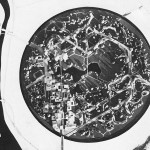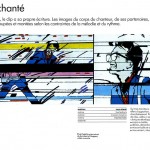An epicenter of polemics since its birth, the Centre Pompidou, also known as Beaubourg, (after the working-class neighborhood that once occupied its site), is one of the few avant-garde contemporary institutions that most attracted the criticism of the intellectual class of 1970’s France and the world. Renzo Piano and Richard Rogers’ design, grounded in the belief of a technology able to free man from work, was seen more as a monumentalization and taming of 1968 energies (Simon Sadler). Particularly harsh, French sociologist and philosopher Baudrillard described the Beauburg as a “Model of all future forms of controlled ‘socialization’: the retotalization of all the dispersed functions of the body and of social life.”


Despite the controversy, or maybe probably hidden behind it, a book came out almost unnoticed in those days, with the title “La soi-disante utopie du Centre Beaubourg” (“The So-called Utopia of Centre Beaubourg”), by one Gustave Affeulpin. Even before the construction of the Art center was completed and the institution started to proclaim its political agenda of uncovering underground creativity, a second beaubourg (with lowercase “r”) was already opened underground, literally, right beneath the original one. In the form of a first person chronicle, the book tells the story of this singular space.


An epicenter of creative production against consumption, of radical making and communal life, this anti-architectural -science-fiction- hole in the ground (54 levels for 7 million cube meters of disposable volume) was a sort of mitopoietic non-place, opened to everyone, from bankers to junkies, activists and criminals, and destined to contain culture, without any a priori definition. According to Elizabeth Schambelan, (“The view from below” Artforum, October 2007) what was really produced there was a ‘”lived critique” of something even more fundamental to Western culture than capitalism–namely, “internalized respect for Authority.”‘ (although we disagree with such an assumption, as we identify the former as the condition for the latter, not as two separate circumstances).
In the underbelly of the beaubourg, private property and leadership hierarchies are abolished. Sexual behaviour and every conventional bourgeois mores like sleeping, hygiene, eating, parenting, learning, dressing, keeping track of time are overturn. Even the need for a personal name is considered pointless. Totally unknown people begin working together according uniquely to their spiritual needs, they share their part-time shifts outside or refuse their daily jobs altogether; notable figures like Sartre, Cardin and even Pontus Hulten (first director of the original Pompidou) happily assert they would rather spend more time there.

As more beaubourgs spring up everywhere and the world seems to be affected by this experiment, Affeulpin can finally state : “The arts … have become the rehearsals, the practicing of the art of living, the only big Art. Culture stops being the substitute of the art of living, and History begins.”
Yet, unfortunately, we would add, neither this underground beaubourg, nor the author of the chronicle really existed, “Gustave Affeulpin” being the pseudonym of Swiss sociologist Albert Meister, who wrote the book in 1976 and projected it in 1986, ten years into the future. So, why does the cover of the English volume state Luca Frei as the author? Is Albert Meister too, another fictional character?
Not really: Albert Meister, French sociologist was not only a real person, but he was a true mindblowing figure: as a researcher at the Ecole des Hautes Etudes de Paris, he was one of the most competent scholar specialist of self-organized communities. He collaborated to regional decentralization programs inspired by Adriano Olivetti and even studied inflation as transational dynamics. After living and working peripathetically through Kyoto, Belgrade, Geneva, Buenos Aires, Rosario, and Tucuman, he died in Tokyo in 1982, leaving behind a trail of publications: books such as L’Afrique peut-elle partir?( 1966), Où va l’autogestion yougoslave? (1970), L’inflation creatrice (1975), L’autogestion en uniforme (1981) and other papers signed under a number of pseudonyms (A. Sigolfa, C. Sniffe-Neef, Nepeutze, Gustave Joyeux).
In fact, the 2007 edition by Luca Frei is essentially an annotated, faithful translation and useful revitalization of a document otherwise lost in obscurity. Switzerland born, Luca Frei is a multi media performative artist, researcher, writer with a longtime interest in the everyday life, the production of space, the “archive”. Several of his works directly refer to the Pompidou. In Meister, Frei appreciated the combination of “a sort of absurdist humor with “very committed ideas,” so as to “challenge more dogmatic ways of writing, and of course reading.”


In a time of permanent Capitalism crisis, continuous uprisings and springing of communities like Occup-ies all over the world, what is the possible reading of such an old-school parable? Well, to begin with, the book has nothing to do with 1970’s political cliches. In fact, together with bourgeois attitudes, Meister and his “beaubourgians” reject the mere ideology of “political participation”, they recognize a fair share of idiots also in the Socialist Party and state that all past revolutions have been failures. In fact, there is no Utopia, no perfect non-place, in this underground beaubourg.
Coming back to Elizabeth Schambelan’s “The view from below“, the author tracks the political discourse of Meister sociology, analyzing his theoretical 1972 Vers une sociologie des associations (“Toward a Sociology of Associations”). In that book, she maintains, Meister seems to be “diagnosing the ills of our own present, no of his”, forecasting a technocratic society of informational elites, characterized by a widening gap between masses and power and no outright oppression, because authoritarianism does not need to manifest itself any longer in this way. A society in which people are withdrawing into their “increasingly comfortable home[s],” with surveillance intruding in their private lives and under the “totalitarianism of mass media. “Participatory democracies are faltering as citizenries turn into vast “commercial clientele[s],” bent on the purchase of “immaterial products.” The counterculture has been neutralized, and a toxic “symbiosis” has developed between capital and the “neoartisanal sector.”


Even though Meister states that perhaps the system can be turned against itself via the subversive use of science and electronics, the only factual strategy he seems to adopt is the one of the refusal of strategy altogether: “All we want is to refuse what will continue to keep [the world] in its grip for a long time: money and power”, says Affeulpin, “The only way to refuse the system is to negate it, to ignore it.” We are not completely convinced by Schambelan when she writes that she finds an echo of Mario Tronti’s 1965 “Strategy of the refusal” in Meister’s divertissement, (read “L’operaismo italiano e il suo Sessantotto lungo vent’anni“, an Italian critical appraisal of the movement in Quinterna/n+1). If a liaison dangereuse has to be provided, why not find it in the Occupy movement or other possible future manifestations as a possible staging ground for revolutionary ambitions, despite their obvious shortcomings? As Twitter user “The future society” (@qqueegueg) recently wrote: “OWS has a life of its own, it is already a foreign body in this society”.
Images:
01: The building of the beaubourg. Source
02/03/04/05/06/07 : Cover, introduction and illustrations from Luca Frei – Casco edition
08: Different editions/translations of the book
09: Illustrations from the Bürozoique French edition
References:
Luca Frei website
Albert Meister on Italian Wikipedia
Le joyeux bordaze d’Albert Meister
Elizabeth Schambelan, (“The view from below” Artforum, October 2007)
La soi-disante utopie du centre beaubourg, Albert Meister – Bürozoique (a French modern re-edition), see latest illustrations.
Sotto il beaubourg, Albert Meister – Eleuthera (Italian edition)
Quinterna, Occupy the world together
All the rights of the images are reserved and property of the respective authors and publishers.




[…] og bearbejdning af original af Albert Meister under pseudonymet Gustave Affeulpin fra 1976. Mere herom. Desværre ‘out of […]